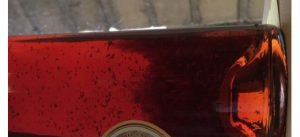Sediment in Cognac
The cognac industry is quite touchy about the appearance of a bottle of cognac. In the world of high value spirits, sediment is not desirable as it can either lie on the bottom of the bottle or cause cloudiness of the spirit. But is it really a problem?
 Well, we all understand that cognac is aged in oak casks. Initially it is put into new ones and then, after about 6 – 12 months, it is transferred into old ones. When the casks are new, they are toasted to destroy the harmful tannins in the wood. At this stage, only the good tannins are available in the wood allowing the cognacs to develop their colour and flavour. Many cognac producers will ask for a specific grade of barrel toasting to suit the desired quality of the finished cognac. Repeated use of the new barrels means that over time, they will become old barrels and so used for long term cognac storage. However, as the tannins in the wood are used up, the inside surface of the barrel will gradually degrade leaving a cloudiness in the cognac.
Well, we all understand that cognac is aged in oak casks. Initially it is put into new ones and then, after about 6 – 12 months, it is transferred into old ones. When the casks are new, they are toasted to destroy the harmful tannins in the wood. At this stage, only the good tannins are available in the wood allowing the cognacs to develop their colour and flavour. Many cognac producers will ask for a specific grade of barrel toasting to suit the desired quality of the finished cognac. Repeated use of the new barrels means that over time, they will become old barrels and so used for long term cognac storage. However, as the tannins in the wood are used up, the inside surface of the barrel will gradually degrade leaving a cloudiness in the cognac.
The level of cloudiness will depend on the age and size of the barrel, the type of oak used and the level of toasting initially agreed between the cooper and distiller. The strength and cru of the cognac are also factors. Cognacs produced from the Champagnes mature more slowly than those from other crus. The spirit remains stronger in the barrel for longer, producing a cloudy effect and in some cases, containing minute particles from inside the barrel. As a result, older cognacs, which may have been in their barrels for 40, 50, 60 or more years, may have levels of sediment in them and must be filtered. In most cases, sediment appears at the tail end of the barrel and because it can be very fine, can be missed when bottling. No producer wants to see sediment of any level in his cognac although it is harmless and will gradually settle in the bottle over time.
When filtering is used to remove the sediment it can be costly as it is slow and some of the cognac is lost during the process. All cognacs do have a minute solids content which is not visible but is part of the cognac. But remember, the longer it has been in the barrel the finer the cognac will be!
